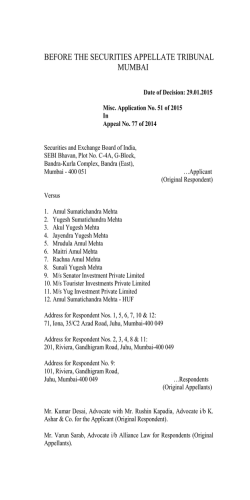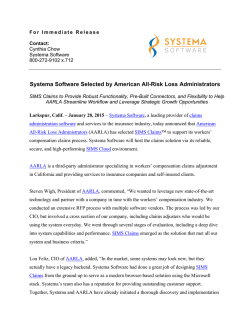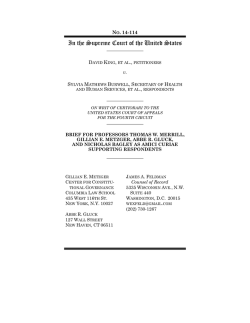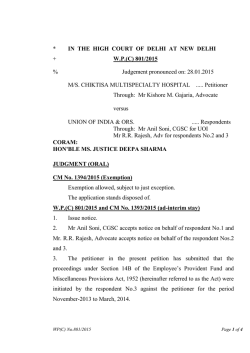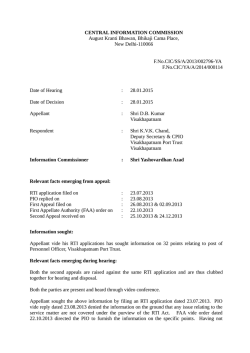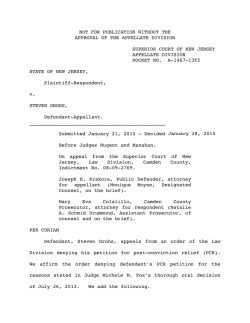
tentative ruling - Crime and Consequences Blog
SUPERIOR COURT OF CALIFORNIA COUNTY OF SACRAMENTO DATE/TIME: January 30, 2015 10:00 a.m. JUDGE: HON. SHELLEYANNE W. L. CHANG DEP. NO.: CLERK: 24 E. HIGGINBOTHAM BRADLEY WINCHELL and KERMIT ALEXANDER, Petitioners, Case No. 34-2014-80001968 vs. JEFFREY A. BEARD, Respondent. Nature of Proceedings: DEMURRER TO PETITION FOR WRIT OF MANDATE; EX PARTE APPLICATION FOR ORDER SHORTENING TIME FOR APPLICATION TO INTERVENE AND PROPOSED DEMURRER The following shall constitute the Court’s tentative ruling on the above matters, set for hearing in Department 24, on Friday, January 30, 2015, at 10:00 a.m. The tentative ruling shall become the final ruling of the Court unless a party wishing to be heard so advises the clerk of this Department no later than 4:00 p.m. on the court day preceding the hearing, and further advises the clerk that such party has notified the other side of its intention to appear. If a hearing is requested, oral argument shall not exceed 20 minutes per side. Petitioners seek a writ of mandate directing Respondent 1 to (1) promulgate within 30 days a temporary regulation to administer the death penalty by lethal injunction, (2) commence within 30 days the procedure for promulgating a permanent regulation for administration of the death penalty by lethal injection that complies with federal law, and (3) directing Respondent to state why petitions requesting promulgation of the aforementioned regulations were denied (Petition). Respondent demurs to the Petition, on the basis that Petitioners lack standing, and that CDCR’s actions or inactions are not subject to writ relief. The demurrer is OVERRULED. 1 Respondent is the Secretary of the California Department of Corrections and Rehabilitation (CDCR). -1- I. Ex Parte Request for Order Shortening Time on Motion to Intervene and Proposed Demurer In Intervention Mitchell C. Sims, an inmate on California’s death row, has moved ex parte for an order shortening time to intervene and for the Court to consider his demurrer, pursuant to California Rule of Court, Rule 3.1300, subdivision (b) and Code of Civil Procedure section 387. 2 Petitioners object to the motion, namely because of Mr. Sims’ proposed demurrer; they do not object to Mr. Sims’ intervention in the matter. Respondent does not object to Sim’s motion. Sims replies that Petitioners’ objections are inapposite, as Sims only attached the demurrer because it was required by Code of Civil Procedure section 387, subdivision (a), apparently to show Sims’ alignment with Respondent. The Court DENIES Sims’ ex parte request for an order shortening time on his motion to intervene without prejudice, as Sims attaches no complaint in intervention as required by statute. Code of Civil Procedure section 387, subdivision (a) provides that: “An intervention takes place when a third person is permitted to become a party to an action or proceeding.., either by joining the plaintiff in claiming what is sought by the complaint, or by uniting with the defendant in resisting the claims of the plaintiff…and is made by complaint, setting forth the grounds upon which the intervention rests, filed by leave of the court and served upon the parties….A party served with a complaint in intervention may within 30 days after service move, demur, or otherwise plead to the complaint in the same manner as to an original complaint.” Thus, because Sims’ application for leave to intervene is not proper (Bowles v. Superior Court (1955) 44 Cal.2d 574, 589), Sims’ ex parte request for an order shortening time is denied without prejudice. Accordingly, the Court also denies Sims’ application to file a demurrer that exceeds the page length requirements. II. Background Petitioners are relatives of murder victims. The convicted murderers, Michael Morales and Tiequon Cox, were sentenced to death, but have not been executed, due to federal and state case law decisions enjoining current procedures or regulations governing lethal injection and due to the fact that CDCR has not promulgated new regulations. (Petition, ¶¶1-2.) CDCR is responsible for establishing standards for execution of death sentences. (Petition, ¶4 (citing Pen. Code Section 3604).) 2 Mr. Sims’ ex parte motion for an order shortening time for a hearing on the application for intervention and proposed demurrer was originally filed on Judicial Council Form FL-300. Petitioners did not object to the motion being filed on this form, and Mr. Sims subsequently filed and served an application for an order shortening time on the parties with a substantively similar declaration supporting the request. Accordingly, the Court will not deny the motion on this basis. -2- The Petition alleges that on February 14, 2006, the Federal District Court for the Northern District of California conditionally denied Michael Morales's motion for a preliminary injunction against his execution. The order permitted CDCR to proceed if it adopted a single-drug, barbiturate-only method in lieu of the three-drug method prescribed by the existing protocol. (Petition, ¶5 (citing Morales v. Hickman (ND Cal. 2006) 415 F.Supp.2d 1037, 1047).) The Petition alleges that CDCR “amended its execution protocol” in 2007. This “protocol” was enjoined by the Superior Court of Marin County, which decision the Court of Appeal affirmed. (Petition, ¶6 (citing Morales v. CDCR (2008) 168 Cal.App.4th 729, 732).) In April 2009, CDCR published a notice promulgating another “three-drug protocol” for lethal injection of condemned inmates, as proposed regulations. The Office of Administrative Law approved the proposed “protocol.” The “protocol” was then again enjoined by the Superior Court of Marin County, which decision was affirmed by the Court of Appeal. (Petition, ¶7 (citing Sims v. CDCR (2013) 216 Cal.App.4th 1059).) On April 26 2012, CDCR advised the “the court” in the aforementioned litigation that “under the Governor’s direction, [CDCR] will also begin the process of considering alternative regulatory protocols…for carrying out the death penalty.” (Petition, ¶8.) No such regulation has been promulgated. (Ibid.) Petitioners allege that the executions of Michael Morales and Tiequon Cox have not occurred because CDCR has failed to adopt a lethal injection protocol that meets federal and state requirements. (Petition, ¶8.) Petitioners petitioned CDCR pursuant to Government Code section 11340.6 to adopt lethal injection regulations, both on an interim and permanent basis. (Petition, ¶¶11-12.) CDCR denied the petitions. (Ibid.) III. Discussion The Court GRANTS Respondent’s unopposed request for judicial notice in support of the demurrer. A petition for writ of mandate is subject to a demurrer on the same grounds as a civil complaint. (Code Civ. Proc., § 1109; Rodriguez v. Municipal Court (1972) 25 Cal.App.3d 521, 526.) In reviewing a demurrer, the trial court considers the properly pleaded material facts and matters that may be judicially noticed and tests their sufficiency. (Cedar Fair, L.P. v. County of Santa Clara (2011) 194 Cal.App.4th 1150, 1158-1159.) The Court will not “assume the truth of contentions, deductions or conclusions of fact or law and may disregard allegations that are contrary to the law or to a fact of which judicial notice may be taken.” (Cochran v. Cochran (1998) 65 Cal.App.4th 488, 483.) -3- a. Standing As an initial ground for demurrer, Respondent contends that Petitioners do not have standing to sue. The Court disagrees. To meet the standing requirement for a petition for writ of mandate, a petitioner must show that he is beneficially interested in the outcome. (Sacramento County Fire Prot. Distr. v. Sacramento County Assessment Appeals Bd. (1999) 75 Cal.App.4th 327, 331 [citing Code Civ. Proc., § 1086].) "’Beneficially interested’ generally means the petitioner has ‘some special interest to be served or some particular right to be preserved or protected over and above the interest held in common with the public at large.’” (Ibid.) Petitioners are beneficially interested in the outcome of this litigation, as they allege that they are crime victims. Courts have also recognized “a public interest exception to the requirement of a beneficial interest: ‘[W]here the question is one of public right and the object of the mandamus is to procure the enforcement of a public duty, the [petitioner] need not show that he has any legal or special interest in the result, since it is sufficient that he is interested as a citizen in having the laws executed and the duty in question enforced.’….The policy underlying the public interest exception "may be outweighed in a proper case by competing considerations of a more urgent nature.” (Sacramento County Fire Prot. Distr., supra, 75 Cal.App.4th at pp. 330-334.) Respondent also contends that Petitioners lack this type “public interest” standing because recognition of standing of citizens in criminal cases would disrupt the orderly administration of justice. Here, Petitioners seek writ relief to, among other things, compel CDCR to promulgate lethal injection standards. Public interest standing is permissible if “the object of the mandamus is to procure the enforcement of a public duty,” which Petitioners are attempting to do by having CDCR issue regulations. (Board of Social Welfare v. County of Los Angeles (1945) 27 Cal.2d 98, 100-101.) Respondent cites Dix v. Superior Court of Humboldt County (1991) 53 Cal.3d 442, to argue that Petitioners’ interest is outweighed by CDCR’s concerns of orderly administering justice. Dix is distinguishable, as Petitioners are not seeking to intervene in a specific criminal case. In Dix, petitioner crime victim sought mandate to overturn the recall order and prevent substitution of a new sentence after respondent Superior Court recalled the defendant's sentence pursuant to Penal Code section 1170(d). The California Supreme Court held that a crime victim did not have standing to intervene in an ongoing criminal proceeding against another person—specifically the decision to recall a sentence. (Dix, supra, 53 Cal.3d at p. 448.) The Court finds that Petitioners have standing to seek writ relief in this matter. b. Mandate Lies to Compel CDCR to Promulgate Standards Respondent argues that demurrer is appropriate, because in seeking a writ to compel CDCR to promulgate temporary, and then permanent, lethal-injection regulations, Petitioners seek to dictate how and when CDCR promulgates such regulations. -4- Respondent argues that mandate does not lie because (1) promulgation of regulations is a discretionary, not ministerial, duty, and (2) Petitioners cannot allege that CDCR has refused to act or has abused its discretion. Penal Code section 3604 governs CDCR’s duty to promulgate standards effectuating the death penalty. It provides in pertinent part that: (a) The punishment of death shall be inflicted by the administration of a lethal gas or by an intravenous injection of a substance or substances in a lethal quantity sufficient to cause death, by standards established under the direction of the Department of Corrections. (Pen. Code, § 3604, subd. (a) (emphasis added).) Thus, Penal Code section 3604, subdivision (a) imposes a mandatory duty upon CDCR to establish “standards” to effectuate either of the two methods prescribed to execute condemned prisoners. (See Newland v. Kizer (1989) 209 Cal.App.3d 647, 654-655 [noting that Health and Safety Code § 1335, providing that the “state department shall adopt regulations for the administration of this article” imposed a mandatory duty on the agency to adopt regulations].) The petition alleges 3 that CDCR has not done so, and has failed to do so for at least two and a half years. 4 (Petition, ¶8.) “Mandate is an appropriate remedy to compel administrative agencies to issue regulations.” (Newland, supra, 209 Cal.App.3d at p. 654; see also Santa Monica Prop. v. Santa Monica Rent Ctrl. Bd. (2012) 203 Cal.App.4th 739, 756 [assuming without deciding that rent control board could be compelled to initiate rule-making process].) Thus, mandate is an appropriate remedy to compel CDCR to issue standards to effectuate Penal Code section 3604. Respondent is correct that mandate will not lie to dictate the content of such regulations or standards, as mandate is unavailable to control the discretion within the area lawfully entrusted to the agency. (AIDS Healthcare Found. v. Los Angeles Co. Dept. of Pub. Health (2011) 197 Cal.App.4th 693, 704 [Health & Safety Code statutes did not impose mandatory duty on county to impose regulations to require condom use and Hepatitis B vaccinations in adult films]; see also Santa Monica, supra, 203 Cal.App.4th at p. 757 [rent control law did not impose mandatory duty on rent control board to adopt regulations imposing remedy or penalty to enforce board’s mandatory duty to issue a final decision within 120 days]; see also Faulkner v. California Toll Bridge Authority (1953) 40 Cal.2d 317, 326.) 3 In its Reply Brief, CDCR argues that Petitioners have not actually pleaded that CDCR refused to act or abused its discretion by not promulgating regulations. To the contrary, the Petition alleges that CDCR has not promulgated regulations for carrying out the death penalty following CDCR’s advisement to the Court of Appeal that it would do so, and the Petition alleges that no regulations have been promulgated since the Court of Appeal’s decision. (Petition, ¶8.) 4 CDCR contests the allegation that it has not acted for this length of time because the Court of Appeal decision in Sims v. CDCR, supra, 216 Cal.App.4th 1059, was not ”filed until May 30, 2013.” In any event, the accuracy of Petitioner’s claim that CDCR has not timely acted is properly resolved in a later proceeding on the merits of this case. -5- However, “mandate simply to issue regulations does not prescribe the substance and content of such regulations or otherwise compel [CDCR] to exercise its administrative discretion in any particular manner.” (Newland, supra, 209 Cal.App.3d at p. 655.) Because the first cause of action alleges that CDCR has violated its statutory duty to promulgate standards pursuant to section 3604, mandate will lie to compel CDCR to do so. Thus, the Petition has stated a valid cause of action for mandate to compel CDCR to promulgate standards, or regulations. The Court will not excise the parts of the Petition that do or do not state valid causes of action, as Respondent demurs to the entire Petition, and the Court has found that the First Cause of Action Petition states a cause of action for writ of mandate compelling CDCR to promulgate standards effectuating Penal Code section 3604. 5 Accordingly, the demurrer is OVERRULED. (Warren v. Atchison, Topeka & Santa Fe Ry. Co. (1971) 19 Cal.App.3d 24, 36 [a demurrer to the entire complaint may be overruled if any cause of action therein is properly stated].) For this reason, the Court also does not consider the argument that purports to demur to the Second Cause of Action. IV. DISPOSITION The demurrer to the Petition is OVERRULED. Respondents’ demurrer to the Petition is OVERRULED. Respondent is to answer the Petition within 10 days as provided in Rule of Court 3.1320(g). If this ruling becomes the final ruling of the Court, it shall be confirmed by minute order and no further order is required. 5 Respondent also objects that the Petition seeks to control the timing of the regulations by seeking mandate to compel CDCR to adopt emergency regulations. The decision whether to adopt emergency regulations is an act within CDCR’s discretion. Penal Code section 5058.3, which governs emergency adoption, amendment or repeal of regulations, provides that CDCR must comply with the Administrative Procedures Act (APA) (Government Code sections 11340 et seq.) unless CDCR determines that its operational needs require adoption of the regulation on an emergency basis. (Pen. Code, § 5058.3.) CDCR’s determination whether its operational needs justify adopting an emergency regulation that does not follow the APA, is a matter within the agency’s discretion. However, this request is in the prayer for relief, and not the cause of action for writ of mandate directing CDCR to “establish standards” under Penal Code section 3604. -6-
© Copyright 2026
